

 |
| Lawyer, having his offices in Rio de Janeiro city, became a orchidist in what he calls his third beginning, in 1986, when he visited, for first time, the "Orquídea Collection", which has been a well succeeded series of annual shows that OrquidaRIO used to perform in the Shopping Rio Design Center, in Leblon quarter, in Rio de Janeiro. |
 |
|
During this event, he became an associate of OrquidaRIO, where he has been in charge of many duties in the Board of Directors. |
| -
How did you start to cultivate orchids? Which was the magic moment of attraction? - The interest in orchids comes far from my childhood lived in small towns in the interior of the state of Bahia, where my father was a judge. He was this kind of man called amateur naturalist. He used to do long strolls, through the wood, up and down hills, following the stream of water and, always, making me to go along with him. I owe to this and to the sports he induced me to practice, the good health I have until today. During those strolls, many times, I ran across with unusual plants, growing on the rock or in branches of trees and shrubs of the "caatinga" and the small wood, which he, in a respectful attitude, told me they were orchids (there, I should be learned that orchid is a religion, not just exercising the leisure...). The "contamination" should have taken bythis time. I found peculiar that the flowers, beautiful but small, needed so long floral spike. He explained to me that this was related to the reproduction, that plants should throw their flowers to a more clear and sunny place to attract and be noticed by the insect pollinator. Now, I know that we talked about Laelia bahiensis, some species of Encyclias and, possibly also, about Catasetum and Cyrtopodium and, for sure, about Cattleya aclandiae (this one not in the caatinga, but in the areas of the Recôncavo where, we also lived or visited, as he traveled a lot) All those things remained hired in emotive memory by years and years, until the interest manifested itself imperious, in Teresópolis, around l983, when I have the construction of my country house finished and I installed my self there. In the mountainous region, I walk through the woods and hills (so different from those of my childhood...), by this time, searching for begonias, which are greatly beautiful there. |
| In a certain day, I was in the wood when the wind started to blow strongly and I decided to come back, since in those circumstances the wood becomes aggressive and dangerous. I was wearing a straw hat and I felt that something dropped on it, might be a leave or a small branch. Walking against the wind, I should maintain my head hanged and keep the hat with one of my hands, because the other was busy with the collected plants. An intense scent followed me until the house. When I took the hat off, a small clump of an orchid plant dropped, bearing long floral hanged spikes with small yellow-greenish flowers, reason of the intense scent, nowadays, I know it was a Gomesa recurva.
This was the first orchid of my collection. If you want to know the "magic moment", I have this one to offer you, especially this experience of feeling the scent, which is wonderful. Since there I haven't stopped any more... |
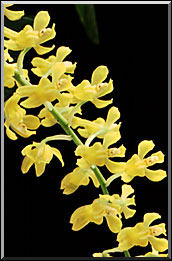 Gomesa
recurva
|
|
By the way, just recently the scents started to be seriously treated, with the publication of essays about the subject (Orquidário magazine, as a matter of fact, has been publishing an excellent series of articles written by an associate, Professor Antonio Ventura Pinto) and there are shows that include the judgment of scents. You should have done this experience of, knowing the time the plant prepares itself to be pollinated, water it to provoke the exhalation of the perfume in its plenitude. |
|
- Was there any another inspiration or did someone inspire you to cultivate orchids besides your father? As I said, my father (as a matter of fact, this succession is a constant between the orchidists, by genetic or oral tradition, we could mention many examples, Sandra Odebrecht, Amândio Pinho Caetano Jr., Maurício Verboonen, Aleksandro Zaslawski, do Espírito Santo, the Robert, in the State of Paraná, the Seidel in the state of Santa Catarina, etc....).In my third orchidist phase, I owe, enormously, to Álvaro Pessôa, Roberto Agnes, Francisco Miranda, Waldemar Scheliga, Alexis Sauer, Carlos Eduardo de Britto Pereira and, mainly, to the fact of becoming associate to OrquidaRIO, which allowed me have a more systematic vision of the orchidophilia and horticulture. I have an interesting souvenir of my admittance: Who introduced me and my "best man" was Hans Frank who gave, when I hardly signed the proposition, a Catasetum cernuum, that I still have. |
| -
How many plants do you have? - I have never counted. Let us do an exercise of calculation. Here, in Rio de Janeiro city, in the terrace of the flat where I lived, in Botafogo quarter, I have a small greenhouse where I cultivate at about 300 plants that I love and will not survive in Teresópolis, where I have the most part. Here, I have Dendrobium from hot climate, Vanda and Phalaenopsis, besides a few more, Cattleya (aclandiae, granulosa and just few hybrids) and Oncidium, with what I do some experiences about the possibility of adaptation to this kind of climate and conditions of cultivation. |
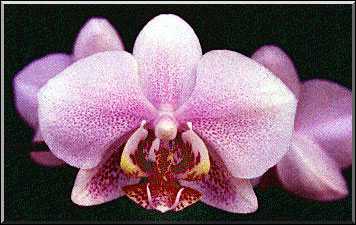 Phal. French Delight |
| This is an research I have been doing and I still did not get to any conclusion. As I said, the most part of my collection is kept in Teresópolis, mountainous region, intermediate climate, with peaks of strong coldness, reaching almost zero during rigorous winter, very much humid during the springtime and summer, but very reduced during the winter and the fall, at least, in my place, Quebra-Frasco quarter. During the winter, the humidity is about 15%. I have a good quantity of plants but I have never counted. But we can do an evaluation. |
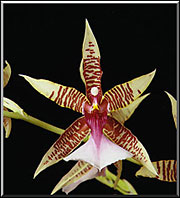
Oncidium hastilabium |
|
I have three greenhouses, with approximately 400 m². Inside them, the areas of cultivation, lathes, etc. can reach at about 200m². Since we can cultivate about 40 plants per m², I have room to put 8.000 pots. In fact, I should have something between four and five thousands plants, since I do not crow the lathes and let enough room between the pots to provide aeration and to avoid the infection of diseases and pests. |
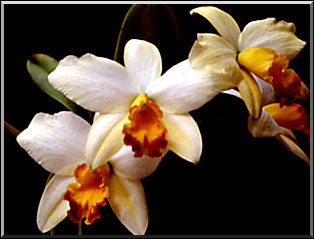 Lc. Mem Helena Eyer |
| - Which orchids do you have more? |
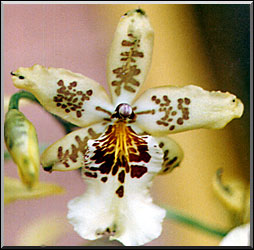 |
I cultivate a little of everything, everything possible to be cultivated, since my vision of orchid is the esthetic and my sensorial experience, my passion is the beauty, varied, the most possible.
Cultivating just a few genera and species, is another kind of vision orchidists where you concentrate and deepen but you lose in variety, such as having flowers just in a period of year and lose the experience of the varieties of the forms, colors and perfumes. I am able to follow the alphabet to you : A, from Ada, B, from Bulbophyllum, C, from Cattleya, D, fromDendrobium, E, from Epidendrum and throughout until Z, from Zygopetalum, going through Wilsonara, Yosufara, etc., etc. and put etc. on it... |
|
- Why did you choose so many kinds of orchids? |
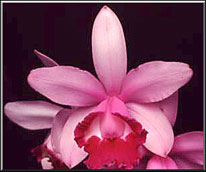 Cattleya intermedia |
-
The answer is implicit in what I have already said, although in my collection, as in any Brazilian collection, there is the predominance of the genus Cattleya and inter and intra generic hybrids, it does not mean a special preference, but the fact that the supplying of those plants are more accessible, besides, of course, the extreme beauty of the most part of those flowers.
|
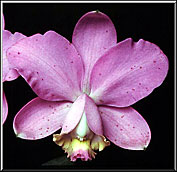 Cattleya loddigesii |
| -
Between yours, what is the favorite plant? -I have already written that my great preference, in a certain moment, was Promenea stapelioides (I feel pity that wonderful hybrids with this genus, such as, for example, with Zygopetalum, are not produced in Brazil but in New Zealand. This is the harm caused by the Brazilian passion for Cattleya)... I have also written that, today, my preference for orchid is orchid. |
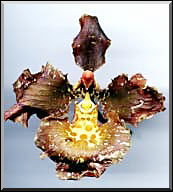 Oncidium crispum |
As a matter of fact, I am not an Euglossinea (*), one of those highly specialized in just one flower... I have moments of preference for these or those orchids, in general those which are in front of me, such us this wonderful Oncidium crispum coming from Serra dos Órgãos (mountainous region) or this Restrepia sanguinea, coming from Ecuador... |
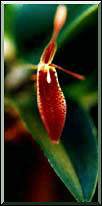 Restrepia sanguinea |
| - How long do you spend taking care of orchids, daily? |
|
-
Not as much I would like... As my nurseries are in Teresópolis and I stay in Rio from Monday until Thursday, the three days of my week-end are totally spent with my one-by-one-plant inspection..., with repotting, fertilizing, doing treatments of pests and diseases. etc. -
As I told before, I could say that I was "made" orchidist
by a Gomesa. - One said that orchidophilia is the soft manifestation of madness, have you done any "orchidophilic" insanity? -
Many, such as paying US$500.00, for a Phalaenopsis Hilo Lip, which nowadays costs US$20.00 an adult species or pay U$1.200,00 for a CD, make in Australia, with the support of RHS and AOS which worked very badly and was very difficult to install and to operate. |
|
-
In fact, I have a period of great curiosity, or, to put in other ways, period of playing the Creator, when I would like to totally dominate, the cycle of the orchid and started to learn who to sow and how to produce clones. For this, I have, mainly, the help of a great orchidist, Roberto Novaes, Professor at the University of Viçosa, in Minas Gerais, who taught me the method of seeding that I still use today and which has the advantage of drastically reducing the possibility of a failure by contamination, besides, because if its simplicity, avoid the used of "cabinet" and other complications. |
| - And about hybridization, we know that you have been doing and we have already published in our pages, a Miltassia created by you and named in honor of your wife, Ophelia. O que anda fazendo nessa linha? |
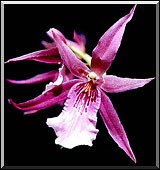 Miltassia Ofelia |
| -
I am reinventing the wheel, or, to put it in other words, I am working to remake with current flowers, old hybrids, such us for example, the natural hybrid, horticulturally known in 1859, Cattleya Isabellae (C. intermedia x C. forbesii). |
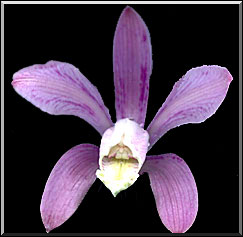 Cattleya Isabella |
| Recently, I have sown Laelia Pastoral Symphony (Laelia pumila x L. sincorana), a hybrid done by J. Miura, in 1990 and Laelia Pulcherrima. Due to the Brazilian progress in genetic improvements, the possibility of remake old hybrids are big and, I think, they will get a superior quality in all aspects: form, size, substance and textures. |
|
- Do you have a cultivation tip that you can share with us? -
A practiced orchidist does not need my tips. To the beginners, I give one: Do not accept tips for cultivation because they are not any good for you. Do not believe in miraculous substrates nor alternative fertilizer or treatments. Until getting knowledge (which occurs, at least, after ten years of experience) be conventional, just use tree fern fiber and clay pots, follow the most common ways of cultivating because you only lose with the experiments. |
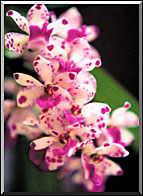 Rhynchostylis gigantea |
| (*) Editor note: Species of bee that pollinates just one genus of orchid |